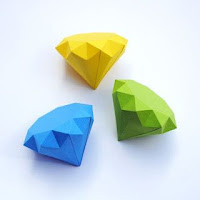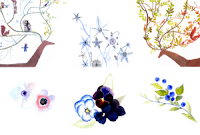Throughout history while the ideas of marriage changed along with the styles of the rings that represented it, the ring finger also changed. Weddings rings have been documented to be worn on every finger, even the thumb.
#jewelleryfacts365 242/365
Thursday, September 29, 2016
Virtually all of the Inkas' golden treasure was melted down, first in a vain attempt to ransom their captured king. Then, after his execution, more gold was commandeered to fill the coffers of the Spanish treasury.
Labels:
jewellery facts
#jewelleryfacts365 241/365 Copper fact
In 1939, the German physician, Werner Hangarter, noticed that Finnish copper miners were unaffected by arthritis as long as they worked in the mining industry. (source)
Labels:
copper fact,
jewellery facts
#jewelleryfacts365 240/365 Gem fact
Benitoite is an unusual mineral found only in the southern part of the Mount Diablo range near the San Benito-Fresno border in California. Because of its similarity in color, it was initially thought to be sapphire. Benitoite is unique in that it crystallizes in a class of the hexagonal system which has a trigonal axis of symmetry. Large stones are unheard of and this stone is not only rare, but also quite attractive. Prices for 1ct. stones could easily exceed prices for almost any diamonds in a similar weight range.
 |
| Benitoite |
Labels:
gem facts,
jewellery facts
#jewelleryfacts365 239/365 Gem fact
Bixbite is the red variety of Beryl, and is classified in the same family as Emerald. This very rare gemstone was mined only at the Wah Wah Mountains deposit in Utah and this deposit is finished for now. The last operators had to totally restore the site when they passed on their option. Anyone wishing to go back and re-open the mine will spend millions just removing the overburden. There may still be red beryl in the ground but it hasn't proven to be economical to pull it out. The largest stones in the world are less than 3cts. in weight and there is zero new production. A fine top color bixbite, even a slightly included one could fetch prices exceeding even the best 1ct. sized diamonds.
 |
| Bixbite |
Labels:
gem facts,
jewellery facts
#jewelleryfacts365 238/365
Some suggest that since Neanderthal times gifts were exchanged as tokens of a special relationship. However the origin of an actual ring being given as a token of love appears to date back to Ancient Egypt, about 5000 years ago. We know this through archaeological evidence which found hieroglyphics depicting wedding bands.
The Egyptian grooms would take plant stems from reeds and rushes, and they’d twist and plait them into rings and bracelets which would then be presented to their brides.
It is believed the Egyptians considered the circular shape a symbol of ever-lasting love and good omens, as it is also the shape of the holy Sun and the Moon.
The hole in the centre of the ring was symbolic of the unknown things to come in their new life as a married couple.
Like many of us today, the Egyptians wore their wedding ring on the 4th finger of the left hand. The origin of this custom is from the belief that there was a vein running from this ring finger, all the way to the heart. So by wearing a ring on this finger you are saying that the person who gave you that ring has a direct link to your heart.
(source)
Labels:
jewellery facts
Bead Day
Saturday, September 24, 2016
 |
| TUTORIAL by Mikki Ferrugiaro Carousel Too Rolled Edge Peyote Bangles |
Labels:
Bead Day
#jewelleryfacts365 237/365 Silver fact
In the 15th century a gift of jewelry was often sent from the father of the bride to father of the groom, proposing the intent to marry off his daughter.
 |
| Silver ring |
Labels:
jewellery facts
#jewelleryfacts365 236/365 Silver fact
Hippocrates wrote that silver had beneficial healing and anti disease properties. The expression 'born with a silver spoon in their mouth' stems from health rather than wealth status, as children fed with silver utensils were believed to be healthier.
 |
| Antique Victorian Silver Leaf Caddy Spoon with Grape and Vine Pattern |
Labels:
jewellery facts,
silver facts
#jewelleryfacts365 235/365 Silver fact
Thursday, September 22, 2016
There are impurities that naturally occur in silver at the molecular level. These impurities consist of other metals - usually copper, but traces of other metals can also be found. These trace impurities are insignificant, and would be too costly to remove - so .999 silver is considered pure.
Labels:
jewellery facts,
silver facts
#jewelleryfacts365 234/365 Gem fact
The most common species of tourmaline is schorl, (brownish or black in colour). It may account for 95% or more of all tourmaline in nature.
 |
| Black tourmaline |
Labels:
gem facts,
jewellery facts
#jewelleryfacts365 233/365 Gem fact
In 1593, Friar De Nica travelled in New Mexico and noted that “the people have emeralds and other jewels, although they esteem none so much as turquoises, wherewith they adorn the wall of the porches of their houses and apparel and vessels, and they use them instead of money through all the country.”
 |
| Blue turquoise cocktail ring, sterling silver |
Labels:
gem facts,
jewellery facts
#jewelleryfacts365 232/365 Sapphire fact
A rare variety of sapphire, known as color changing sapphire, exhibits different colors in different light. A color change sapphire is blue in natural light, and violet in artificial light.
 |
| Owl ring with sapphire eye |
Labels:
jewellery facts,
sapphire facts
#jewelleryfacts365 231/365
A species of hard nut is gaining popularity as a replacement for ivory, although its size limits its usability. It is sometimes called vegetable ivory, or tagua, and is the seed endosperm of the ivory nut palm commonly found in coastal rainforests of Ecuador, Peru and Colombia.
 |
| Tagua carvings |
Labels:
jewellery facts
#jewelleryfacts365 230/365
Both the Greek and Roman civilizations practiced ivory carving to make large quantities of high value works of art, precious religious objects, and decorative boxes for costly objects. Ivory was often used to form the white of the eyes of statues.
 |
| The Byzantine Barberini Ivory from the 6th Century AD has been attributed to a royal workshop in Constantinople. |
Labels:
jewellery facts
Jewellery masterpieces
Friday, September 16, 2016
 |
| Enamel. Marcus Synnot |
Labels:
Jewellery masterpieces
#jewelleryfacts365 228/365 Gem fact
Thursday, September 15, 2016
Jade has been known to Man for some 7000 years. In prehistoric times, however, it was esteemed rather more for its toughness, which made it an ideal material for weapons and tools.
 |
| Jade rock from Alaska |
Labels:
gem facts,
jewellery facts
#jewelleryfacts365 227/365 Gem fact
The most common imitation of turquoise encountered today is dyed howlite and magnesite, both white in their natural states, and the former also having natural (and convincing) black veining similar to that of turquoise. Dyed chalcedony, jasper, and marble is less common, and much less convincing.
 |
| Dragonfly necklace (copper, sterling silver, natural turquoise, blue topaz) |
Labels:
gem facts
Jewellery masterpieces
Tuesday, September 13, 2016
 |
| AN ART NOUVEAU ENAMEL AND DIAMOND BRACELET |
Labels:
Jewellery masterpieces
#jewelleryfacts365 226/365 Gem fact
Tanzanite forms as a brownish crystal and is trichroic - which means it shows three colors - brown, blue and violet concurrently. Heating - either occurring underground naturally by metamorphic occurrences or above ground by man in a furnace removes the brown or burgundy color component to produce a stronger purplish-blue color and makes the stone "dichroic" which means it only reflects blue and violet. (source) Some stones found close to the surface in the early days of the discovery (in an area now called D block) were gem-quality blue without the need for heat treatment - probably the result of a wild fire in the area which heated the stones underground.
 |
| Tanzanite |
Labels:
gem facts,
jewellery facts
#jewelleryfacts365 225/365 Pearl fact
The Greeks explained the origins of pearls in their mythology. To them pearls were tears of joy that Aphrodite, the Goddess of Love, shed when she was born from sea froth.
 |
| Aphrodite earrings |
Labels:
jewellery facts,
pearl facts
#jewelleryfacts365 224/365 Copper fact
The first recorded medical use of copper is found in the Smith Papyrus, one of the oldest books known. The Papyrus is an Egyptian medical text, written between 2600 and 2200 B.C., which records the use of copper to sterilize chest wounds and to sterilize drinking water. (source)
Labels:
copper fact,
jewellery facts
#jewelleryfacts365 223/365
It is estimated that ivory consumption in Great Britain alone in 1831 amounted to the deaths of nearly 4,000 elephants.
 |
| Elephant tusks |
Labels:
jewellery facts
Jewellery masterpieces
Friday, September 9, 2016
 |
| Renaissance Revival 18kt Gold Gem-set Armlet, c. 1880, bezel-set with sapphire and diamond florets, bezel-set sapphire, emerald, and ruby accents, rose-cut diamond highlights. |
Labels:
Jewellery masterpieces
#jewelleryfacts365 222/365 Gem fact
Amber is fossilized tree resin (not sap), which has been appreciated for its color and natural beauty since Neolithic times.
 |
| Vilnius’ Amber Museum |
Labels:
gem facts,
jewellery facts
#jewelleryfacts365 221/365 Egyptian jewellery facts
Thursday, September 8, 2016
Ancient Egyptians used obsidian imported from the eastern Mediterranean and southern Red Sea regions. Obsidian was also used in ritual circumcisions because of its deftness and sharpness. In the eastern Mediterranean area the material was used to make tools, mirrors and decorative objects.
Labels:
Ancient Egypt facts,
jewellery facts
Jewellery masterpieces
Tuesday, September 6, 2016
 |
| Jacob & Co for Madonna |
Labels:
Jewellery masterpieces
#jewelleryfacts365 219/365 Gem fact
Tanzanite gets its name from its origin of Tanzania. In 1967, Manuel d'Souza discovered this extraordinary variety of the mineral zoisite while searching for sapphires. The Tanzania mines are located at the foot of Mt. Kilimanjaro.
 |
| Mt. Kilimanjaro |
Labels:
gem facts,
jewellery facts
#jewelleryfacts365 218/365 Sapphire fact
In ancient times, Sapphires were thought to be protective against envy, and even against poisoning. A common belief was that a venomous snake placed in a Sapphire vessel would rapidly die!
 |
| Silver earrings with sapphires and dumotorite |
Labels:
jewellery facts,
sapphire facts
#jewelleryfacts365 216/365 Gem fact
Obsidian is hard and brittle; it therefore fractures with very sharp edges, which were used in the past in cutting and piercing tools, and it has been used experimentally as surgical scalpel blades.
 |
| Obsidian |
Labels:
gem facts,
jewellery facts
#jewelleryfacts365 215/365 Gem fact
'Jade', or yu, as it is called in China, is strictly speaking a generic term for two different gems, nephrite and jadeite. It was not until the beginning of the 19th century that mineralogists and gemmologists started to differentiate between them. The name "jade" is derived from the Spanish 'piedra de ijada', loin-stone, jade having been recognised by the Amerindians as a remedy for kidney ailments. Because of its beneficial effect on the kidneys, the stone was also known as 'lapis nephriticus'. That, indeed, is where the term 'nephrite' came from. Jadeite is rarer than nephrite and is therefore regarded as more precious. (source)
 |
| Nephrite jade silver earrings |
Labels:
gem facts,
jewellery facts
#jewelleryfacts365 214/365 Gem fact
Tourmaline crystals may be green at one end and pink at the other, or green on the outside and pink inside; this type is called watermelon tourmaline.
 |
| Watermelon tourmaline pendant (sold) |
Labels:
gem facts,
jewellery facts
Subscribe to:
Posts (Atom)






















































